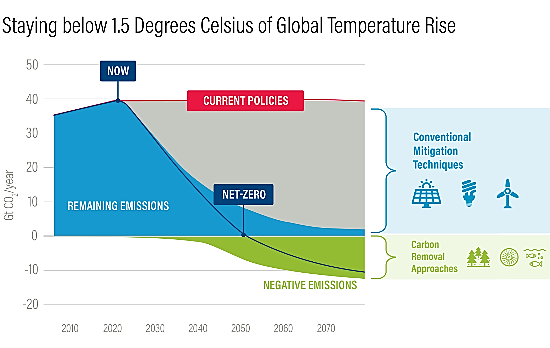The headline describes the significant challenge we face between now, 2030 and beyond. If we want to keep atmospheric temperatures from creeping above the 1.5 Celsius (2.7 Fahrenheit) threshold first established at the Paris COP21 meeting in 2015, this is the immediate job at hand. Based on current climate projections, 1.5 will likely happen within the next two to three years, something very few who attended in Paris would have contemplated as happening this soon.
The current amount of carbon dioxide (CO2) in the atmosphere has a latency that will impact global warming for the next several decades. The CO2 that nature removes has kept the atmosphere from heating up even faster than it is. We have the ocean, forests, soil, grasslands, mangroves, and other natural carbonation processes happening to help us. But they can’t create a carbon deficit to offset the deposits we keep adding. That’s why the necessity to withdraw CO2 over and above what we keep adding or else face rising air and water temperatures, changes in weather patterns and increasing extreme weather events.
The International Energy Agency back in 2020 published an article entitled, “What is the difference between carbon neutral and carbon negative?” It described a plan by Microsoft to get to carbon neutrality by 2030, and by 2050 to have removed all of the carbon the company has emitted since its founding in 1975. In addition, Microsoft announced, along with two pledges, a $1 billion contribution to a climate innovation fund.
So how do we start to do deficit accounting involving 1 Gigaton CO2 withdrawals from the total amount in the atmosphere beginning now and going to 2030 and beyond?
I’ve previously written about how we can by natural or other means reduce atmospheric CO2. Just type in the search window “removing carbon from the atmosphere” and you will uncover 28 articles covering the subject. So consider what follows a reminder and summary of what we can get from nature to mitigate
Nature can help but human commitment to allow it to do its job will involve considerable effort including behaviour changes and sacrifice. I’ve previously written about how nature’s helpers can help in the fight to reduce atmospheric CO2. Just type in the search window “removing carbon from the atmosphere” and you will uncover 28 articles covering the subject. So consider what follows a reminder and summary of what we can get from nature and our technological capabilities to produce annual carbon atmospheric deficits.
What Nature Has to Offer
Several ways nature can help us create atmospheric carbon deficits.
- Changes in Land Use – repurposing existing land to grow forests where none previously existed. The challenge here is that new forests need to mature to become significant carbon sinks. And where the timber industry harvests trees, reforestation represents another way to enhance existing carbon sinks. Again there is a latency issue from replanting to creating mature trees capable of doing their part. And don’t forget that grasslands and wetlands, as well as soils, play a part in removing carbon from the atmosphere.
- Changes in Coastal and Water Use – restoring marine and shoreline habitats including the expansion of existing coastal mangrove forests. Mangroves are significant carbon sinks as well as a terrific way to stop shoreline erosion as sea levels rise. Another strategy is to encourage offshore kelp farms and seagrass growth, both helpful in removing carbon absorbed by our oceans that is altering pH levels to threaten shell-based marine life.
- Changes to the way we farm – Modern soil and crop management can help to absorb carbon from the air. Biomass used to produce biochar can be mixed into farm soils to enhance plant yields while taking up carbon and sequestering in the ground and plants.
- Enhanced weathering – Binding carbon within rocks is a natural process. Limestone comes from carbon and calcium. But we can enhance the amount of carbon absorbed from the atmosphere by adding mineral silicates to soils.
What Technology Can Offer
Our human inventiveness has come up with several carbon deficit strategies. These include:
- Salting the ocean with iron, or with calcium -The first strategy encourages algae blooms that absorb carbon and when the algae die they theoretically would sink to the abyss where it is permanently sequestered, The second produces calcium carbonate which produces limestone. There have been some tests, most unauthorized, testing this approach to carbon capture.
- Carbon capture and sequestration – This is a group of technologies that use the acronym CCS and can be added to existing polluting industries like the burning of fossil fuels to produce electricity, steel, cement, and aluminum. Direct air capture (DAC) technology removes carbon from the atmosphere. In both cases, the captured carbon is then pumped into the ground for permanent geological storage.
The Ongoing Problem
Our current efforts to help nature help us, and in the use of technological innovation are falling well short of reducing the atmosphere’s carbon account. At our best, all we are doing is slowing down the increase of CO2. The current amounts of carbon being removed by natural and technological means is approximately a half-billion tons annually. But what is needed is a ramp-up to 1 gigaton (a billion tons). Considering we are adding between 30 and 35 gigatons annually, with our current carbon removal capacity, it will be impossible to come even close to achieving negative-carbon results every year from now until 2030, let alone beyond to 2050.
















